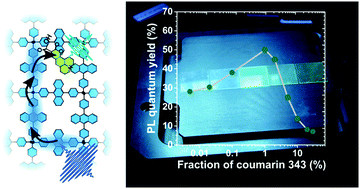当前位置:
X-MOL 学术
›
Phys. Chem. Chem. Phys.
›
论文详情
Our official English website, www.x-mol.net, welcomes your feedback! (Note: you will need to create a separate account there.)
Enhancing the photoluminescence of surface anchored metal–organic frameworks: mixed linkers and efficient acceptors†
Physical Chemistry Chemical Physics ( IF 3.3 ) Pub Date : 2018-01-12 00:00:00 , DOI: 10.1039/c7cp08452h M. Oldenburg 1, 2, 3, 4 , A. Turshatov 1, 2, 3, 4 , D. Busko 1, 2, 3, 4 , M. Jakoby 1, 2, 3, 4 , R. Haldar 2, 3, 4, 5 , K. Chen 6, 7, 8, 9 , G. Emandi 10, 11, 12, 13, 14 , M. O. Senge 10, 11, 12, 13, 14 , C. Wöll 2, 3, 4, 5 , J. M. Hodgkiss 6, 7, 8, 9 , B. S. Richards 1, 2, 3, 4, 15 , I. A. Howard 1, 2, 3, 4, 15
Physical Chemistry Chemical Physics ( IF 3.3 ) Pub Date : 2018-01-12 00:00:00 , DOI: 10.1039/c7cp08452h M. Oldenburg 1, 2, 3, 4 , A. Turshatov 1, 2, 3, 4 , D. Busko 1, 2, 3, 4 , M. Jakoby 1, 2, 3, 4 , R. Haldar 2, 3, 4, 5 , K. Chen 6, 7, 8, 9 , G. Emandi 10, 11, 12, 13, 14 , M. O. Senge 10, 11, 12, 13, 14 , C. Wöll 2, 3, 4, 5 , J. M. Hodgkiss 6, 7, 8, 9 , B. S. Richards 1, 2, 3, 4, 15 , I. A. Howard 1, 2, 3, 4, 15
Affiliation

|
We present two approaches to enhance the photoluminescence quantum yield (PLQY) of surface-anchored metal–organic frameworks (SURMOFs). In the first approach we fabricate SURMOFs from a mix of an emissive linker with an optically-inert linker of equivalent length, diluting the emissive linker while maintaining the SURMOF structure. This approach enhances the internal PLQY. However, the increase in internal PLQY is achieved at the expense of a drastic reduction in optical absorption, thus the external PLQY remains low. To overcome this limitation, a second approach is explored wherein energy-accepting guest chromophores are infiltrated into the framework of the active linker. At the correct acceptor concentration, an internal PLQY of 52% – three times higher than the previous approach – is achieved. Additionally, the absorption remains strong leading to an external PLQY of 8%, an order of magnitude better than the previous approach. Using this strategy, we demonstrate that SURMOFs can achieve PLQYs similar to their precursor chromophores in solution. This is of relevance to SURMOFs as emitter layers in general, and we examine the optimized emitter layer as part of a photon upconversion (UC) SURMOF heterostructure. Surprisingly, the same PLQY is not observed after triplet–triplet annihilation in the UC heterostructure as after its normal photoexcitation (although the UC layers exhibit low thresholds consistent with those reported in our previous work). We discuss the potential bottlenecks in energy transport that could lead to this unexpected reduction in PLQY after excitation via triplet–triplet annihilation, and how future design of SURMOF UC multilayers could overcome these limitations.
中文翻译:

增强表面锚定的金属有机框架的光致发光:混合的连接子和有效的受体†
我们提出了两种方法来增强表面锚定的金属有机框架(SURMOFs)的光致发光量子产率(PLQY)。在第一种方法中,我们由发射连接体与等效长度的光学惰性连接体的混合物制造SURMOF,在保持SURMOF结构的同时稀释了发射连接体。这种方法增强了内部PLQY。然而,内部PLQY的增加是以光吸收的急剧减少为代价的,因此外部PLQY保持较低。为了克服该限制,探索了第二种方法,其中将能接受能量的客体发色团渗透到活性接头的框架中。在正确的受体浓度下,可实现52%的内部PLQY(比以前的方法高三倍)。此外,吸收仍然很强,导致外部PLQY为8%,比以前的方法好一个数量级。使用这种策略,我们证明了SURMOFs可以实现PLQY,类似于它们在溶液中的前体发色团。通常,这与SURMOF作为发射极层有关,我们将优化的发射极层作为光子上转换(UC)SURMOF异质结构的一部分进行检查。出人意料的是,在UC异质结构中三重态-三重态an灭后,未发现与正常光激发后相同的PLQY(尽管UC层的阈值与我们先前的工作一致)。我们讨论了能量传输中的潜在瓶颈,这些瓶颈可能导致激发后PLQY的这种意外降低 比以前的方法好一个数量级。使用这种策略,我们证明了SURMOFs可以实现PLQY,类似于它们在溶液中的前体发色团。通常,这与SURMOF作为发射极层有关,我们将优化的发射极层作为光子上转换(UC)SURMOF异质结构的一部分进行检查。出人意料的是,在UC异质结构中三重态-三重态an灭后,未发现与正常光激发后相同的PLQY(尽管UC层的阈值与我们先前的工作一致)。我们讨论了能量传输中的潜在瓶颈,这些瓶颈可能导致激发后PLQY的这种意外降低 比以前的方法好一个数量级。使用这种策略,我们证明了SURMOFs可以实现PLQY,类似于它们在溶液中的前体发色团。通常,这与SURMOF作为发射极层有关,我们将优化的发射极层作为光子上转换(UC)SURMOF异质结构的一部分进行检查。出人意料的是,在UC异质结构中三重态-三重态an灭后,未发现与正常光激发后相同的PLQY(尽管UC层的阈值与我们先前的工作一致)。我们讨论了能量传输中的潜在瓶颈,这些瓶颈可能导致激发后PLQY的这种意外降低 通常,这与作为发射极层的SURMOF相关,我们将优化的发射极层作为光子上转换(UC)SURMOF异质结构的一部分进行检查。出人意料的是,在UC异质结构中三重态-三重态an灭后,未发现与正常光激发后相同的PLQY(尽管UC层的阈值与我们先前的工作一致)。我们讨论了能量传输中的潜在瓶颈,这些瓶颈可能导致激发后PLQY的这种意外降低 通常,这与SURMOF作为发射极层有关,我们将优化的发射极层作为光子上转换(UC)SURMOF异质结构的一部分进行检查。出人意料的是,在UC异质结构中三重态-三重态an灭后,未发现与正常光激发后相同的PLQY(尽管UC层的阈值与我们先前的工作一致)。我们讨论了能量传输中的潜在瓶颈,这些瓶颈可能导致激发后PLQY的这种意外降低 在UC异质结构中三重态-三重态an灭后,与正常的光激发后一样,未观察到相同的PLQY(尽管UC层的阈值较低,与我们先前的工作一致)。我们讨论了能量传输中的潜在瓶颈,这些瓶颈可能导致激发后PLQY的这种意外降低 在UC异质结构中三重态-三重态an灭后,与正常的光激发后一样,未观察到相同的PLQY(尽管UC层的阈值较低,与我们先前的工作一致)。我们讨论了能量传输中的潜在瓶颈,这些瓶颈可能导致激发后PLQY的这种意外降低通过三重态-三重态an灭,以及SURMOF UC多层板的未来设计如何克服这些局限性。
更新日期:2018-01-12
中文翻译:

增强表面锚定的金属有机框架的光致发光:混合的连接子和有效的受体†
我们提出了两种方法来增强表面锚定的金属有机框架(SURMOFs)的光致发光量子产率(PLQY)。在第一种方法中,我们由发射连接体与等效长度的光学惰性连接体的混合物制造SURMOF,在保持SURMOF结构的同时稀释了发射连接体。这种方法增强了内部PLQY。然而,内部PLQY的增加是以光吸收的急剧减少为代价的,因此外部PLQY保持较低。为了克服该限制,探索了第二种方法,其中将能接受能量的客体发色团渗透到活性接头的框架中。在正确的受体浓度下,可实现52%的内部PLQY(比以前的方法高三倍)。此外,吸收仍然很强,导致外部PLQY为8%,比以前的方法好一个数量级。使用这种策略,我们证明了SURMOFs可以实现PLQY,类似于它们在溶液中的前体发色团。通常,这与SURMOF作为发射极层有关,我们将优化的发射极层作为光子上转换(UC)SURMOF异质结构的一部分进行检查。出人意料的是,在UC异质结构中三重态-三重态an灭后,未发现与正常光激发后相同的PLQY(尽管UC层的阈值与我们先前的工作一致)。我们讨论了能量传输中的潜在瓶颈,这些瓶颈可能导致激发后PLQY的这种意外降低 比以前的方法好一个数量级。使用这种策略,我们证明了SURMOFs可以实现PLQY,类似于它们在溶液中的前体发色团。通常,这与SURMOF作为发射极层有关,我们将优化的发射极层作为光子上转换(UC)SURMOF异质结构的一部分进行检查。出人意料的是,在UC异质结构中三重态-三重态an灭后,未发现与正常光激发后相同的PLQY(尽管UC层的阈值与我们先前的工作一致)。我们讨论了能量传输中的潜在瓶颈,这些瓶颈可能导致激发后PLQY的这种意外降低 比以前的方法好一个数量级。使用这种策略,我们证明了SURMOFs可以实现PLQY,类似于它们在溶液中的前体发色团。通常,这与SURMOF作为发射极层有关,我们将优化的发射极层作为光子上转换(UC)SURMOF异质结构的一部分进行检查。出人意料的是,在UC异质结构中三重态-三重态an灭后,未发现与正常光激发后相同的PLQY(尽管UC层的阈值与我们先前的工作一致)。我们讨论了能量传输中的潜在瓶颈,这些瓶颈可能导致激发后PLQY的这种意外降低 通常,这与作为发射极层的SURMOF相关,我们将优化的发射极层作为光子上转换(UC)SURMOF异质结构的一部分进行检查。出人意料的是,在UC异质结构中三重态-三重态an灭后,未发现与正常光激发后相同的PLQY(尽管UC层的阈值与我们先前的工作一致)。我们讨论了能量传输中的潜在瓶颈,这些瓶颈可能导致激发后PLQY的这种意外降低 通常,这与SURMOF作为发射极层有关,我们将优化的发射极层作为光子上转换(UC)SURMOF异质结构的一部分进行检查。出人意料的是,在UC异质结构中三重态-三重态an灭后,未发现与正常光激发后相同的PLQY(尽管UC层的阈值与我们先前的工作一致)。我们讨论了能量传输中的潜在瓶颈,这些瓶颈可能导致激发后PLQY的这种意外降低 在UC异质结构中三重态-三重态an灭后,与正常的光激发后一样,未观察到相同的PLQY(尽管UC层的阈值较低,与我们先前的工作一致)。我们讨论了能量传输中的潜在瓶颈,这些瓶颈可能导致激发后PLQY的这种意外降低 在UC异质结构中三重态-三重态an灭后,与正常的光激发后一样,未观察到相同的PLQY(尽管UC层的阈值较低,与我们先前的工作一致)。我们讨论了能量传输中的潜在瓶颈,这些瓶颈可能导致激发后PLQY的这种意外降低通过三重态-三重态an灭,以及SURMOF UC多层板的未来设计如何克服这些局限性。



























 京公网安备 11010802027423号
京公网安备 11010802027423号